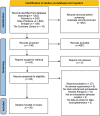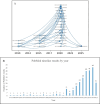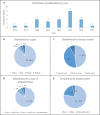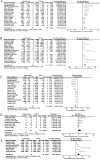The effectiveness of stem cell‑derived extracellular vesicles therapy for intrauterine adhesions: a meta-analysis of preclinical studies
- PMID: 40804676
- PMCID: PMC12345020
- DOI: 10.1186/s12958-025-01448-2
The effectiveness of stem cell‑derived extracellular vesicles therapy for intrauterine adhesions: a meta-analysis of preclinical studies
Abstract
Background: The therapeutic potential of stem cell-derived extracellular vesicles (EVs) for intrauterine adhesions (IUA) has attracted increasing preclinical investigation, yet a comprehensive and up-to-date meta-analysis is currently lacking. Before moving forward with clinical applications, it is essential to fully understand the impact of stem cell-derived EVs on IUA.
Methods: PubMed, EMBASE, Cochrane Library, Web of Science were searched up to May 19th 2025. Trial sequential analysis was conducted to evaluate outcomes, while sensitivity analysis and publication bias assessment were conducted using Stata 14.
Results: Across 26 studies (899 animals), our analyses have uncovered several important findings as the following: stem cell-derived EVs significantly improved the number of endometrial glands (SMD = 3.78; 95% CI: 2.62 ~ 4.93; P < 0.00001); endometrial thickness (SMD = 2.65; 95% CI: 1.90 ~ 3.40; P < 0.00001) and the number of embryos (SMD = 2.00; 95% CI: 1.02 ~ 2.97; P = 0.0004); fibrosis reduction (SMD = -3.25; 95% CI: -4.24~ -2.26; P < 0.00001) in IUA animal models. EVs downregulated fibrosis markers (TGF-β1, α-SMA, Col-1) and upregulated vascularization (VEGF) and proliferation (Ki67) genes.
Conclusions: Stem cell-derived EVs demonstrate safety and efficacy in treating IUA animal models, with potential improvements in fertility outcomes.
Supplementary Information: The online version contains supplementary material available at 10.1186/s12958-025-01448-2.
Keywords: Extracellular vesicles; Intrauterine adhesions; Meta-analysis; Trial sequential analysis.
Conflict of interest statement
Declarations. Ethics approval and consent to participate: This article does not contain any studies involving human and animal subjects performed by any of the Authors. No ethical approval was needed for this review article. Competing interests: The authors declare no competing interests. Clinical trial registry subsections: PROSPERO registration number: CRD42024509713. Date of registration in PROSPERO: 12 March 2024.
Figures







Similar articles
-
Effects and safety of hyaluronic acid gel on intrauterine adhesion and fertility after intrauterine surgery: a systematic review and meta-analysis with trial sequential analysis of randomized controlled trials.Am J Obstet Gynecol. 2024 Jul;231(1):36-50.35. doi: 10.1016/j.ajog.2023.12.039. Epub 2024 Jan 6. Am J Obstet Gynecol. 2024. PMID: 38191020
-
Therapeutic Effects of Mesenchymal Stem Cell-Derived Extracellular Vesicles in sepsis: a Systematic Review and Meta-Analysis of Preclinical Studies.Stem Cell Rev Rep. 2024 Aug;20(6):1480-1500. doi: 10.1007/s12015-024-10741-3. Epub 2024 May 30. Stem Cell Rev Rep. 2024. PMID: 38814410
-
Comparison of effectiveness of hyaluronan gel, intrauterine device and their combination for prevention adhesions in patients after intrauterine surgery: Systematic review and meta-analysis.J Gynecol Obstet Hum Reprod. 2022 Apr;51(4):102334. doi: 10.1016/j.jogoh.2022.102334. Epub 2022 Feb 5. J Gynecol Obstet Hum Reprod. 2022. PMID: 35134573
-
Value of intrauterine platelet-rich concentrates in patients with intrauterine adhesions after hysteroscopy: A systematic review and meta-analysis of randomized controlled trials.Eur J Obstet Gynecol Reprod Biol. 2022 Apr;271:63-70. doi: 10.1016/j.ejogrb.2022.01.030. Epub 2022 Feb 4. Eur J Obstet Gynecol Reprod Biol. 2022. PMID: 35149445
-
Mesenchymal stem cells-derived small extracellular vesicles and apoptotic extracellular vesicles for wound healing and skin regeneration: a systematic review and meta-analysis of preclinical studies.J Transl Med. 2025 Mar 24;23(1):364. doi: 10.1186/s12967-024-05744-0. J Transl Med. 2025. PMID: 40128791 Free PMC article.
References
-
- SANTAMARIA X, ISAACSON K. Asherman’s syndrome: it May not be all our fault [J]. Hum Reprod. 2018;33(8):1374–80. - PubMed
-
- HOOKER A B, LEMMERS M, THURKOW A L, et al. Systematic review and meta-analysis of intrauterine adhesions after miscarriage: prevalence, risk factors and long-term reproductive outcome [J]. Hum Reprod Update. 2014;20(2):262–78. - PubMed
-
- LAVELANET A F, JOHNSON B R JR. Global abortion policies database: a descriptive analysis of the regulatory and policy environment related to abortion [J]. Best Pract Res Clin Obstet Gynaecol. 2020;62:25–35. - PubMed
Grants and funding
- S202410533049/Innovation and entrepreneurship training program for college student
- S202510533012/Innovation and entrepreneurship training program for college student
- 1053320222496/Fundamental Research Funds for the Central Universities of Central South University
- 2024JJ4091/Science Foundation For Excellent Young Scholars of Hunan Province
- 82301835/Excellent Young Scientists Fund of the National Natural Science Foundation of China
LinkOut - more resources
Full Text Sources

